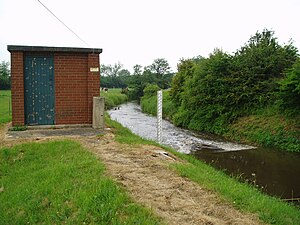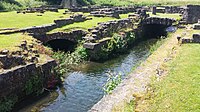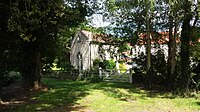Oldcotes Dyke

Oldcotes Dyke is the name of the final section of a river system that drains parts of northern Nottinghamshire and of the south-eastern acres of the West Riding of Yorkshire. Historically, the river has supported milling, with seven water mills drawing their power from its water, and ran through the grounds of a Cistercian monastery, Roche Abbey.
Much of the river has been diverted, straightened and redirected, though it springs from natural watercourses. It is a tributary of the River Ryton.
Route in Yorkshire
The river begins as a small stream near the 410-foot contour and close to the B6093 Moor Lane South road at Ravenfield. If flows to the east, forming the southern boundary of the housing of the village, with open land on its south bank. It passes under Priests Bridge on Lidget Lane, and is briefly culverted as it flows under the M18 motorway and Hellaby Lane, to the north of Hellaby.
It marks the eastern boundary of Hellaby Industrial Park and runs beside a dismanteld railway embankment, where it is joined by an unnamed stream which also rises to the west of the M18. A little further to the south, Hellaby Bridge carries the A631 Rotherham to Bawtry road over the combined flow, and it is joined by Newhall Dike, which rises at Cum Well, further west but to the east of the motorway.
The river turns to the east, flowing along the southern edge of Maltby, to be joined by Kingsforth Brook. This rises besides Second Lane in Wickersley. Heading east it passes through King's Pond Plantation, a wood with a large pond in it, and under the motorway. It passes under Kingsforth Lane and Newhall Lane before turning to the north-east, to join Hellaby Dike. Shortly after passing under Carr Lane, Maltby, it turns to the south, and becomes Maltby Dike.
The first of the historic mills on the river is Hooton Levitt mill. The farmhouse and attached mill building date from the late 18th century, but were rebuilt in the mid-19th century, and are Grade II listed structures. The wheelpit remains, but the breast-shot water wheel and associated machinery are no longer there.[1] It was marked as a corn mill on the 1892 map,[2] Close by there was, in the twentieth century, a sewage works facility, since been removed, and in 2007 Severn Trent Water set out to turn the site into a hay meadow and grassland to become part of the Maltby Low Common nature reserve.[3]

Heading south-east, the river is crossed by the Worksop to Doncaster freight railway. Beyond it, on the southern bank, is the new sewage treatment works, strung out along the river.
The river comes to the grounds of what was Roche Abbey, which the Cistercians founded in 1147 and held until the Dissolution of the Monasteries in the 1530s. The Roche estate was bought by Nicholas Saunderson, 1st Viscount Castleton in 1627. Richard Lumley-Saunderson, 4th Earl of Scarbrough employed the landscape architect Capability Brown to landscape the estate in 1760, and the river forms part of his design.
As part of Capability Brown's landscaping, the monastic channels which had carried the dike through the site for hundreds of years were filled in, to create a meandering stream and a lake, covering the southern part of the complex.[4] Brown's concept of a "romantic ruin" passed out of favour, and James Aveling began the process of excavating the site in the late 1850s. He published a book recording what he had found in 1870, the first such publication about a monastic site in Britain. Larger scale removal of Brown's infilling of the site began in the 1880s, when the 10th Earl of Scarborough ensured that the process was recorded photographically. Responsibility for the ruins passed to the State following the First World War, after which Brown's lake was drained and the original water channels were rediscovered and reinstated. The Office of Works used the work as a way to provide jobs for the unemployed.[5] Two cutwaters are visible, one to the west of the site near the 18th century banquetting lodge, and the other at the east of the site, which carries the public footpath to Laughton Pond. The waters of the dike were used to power a water mill during the monastic period.[4]
Hooton Dike
Just below the Abbey complex, the river is joined by Hooton Dike. This rises on land which was once the edges of Thurcroft Colliery, until its closure in 1991. It flows eastwards under some old railway embankments which were part of the colliery, and the former junction of the Thurcroft Colliery Branch and the defunct Braithwell and Laughton Railway.[6] Beyond the embankments, it is called Brookhouse Dike, and flows under the main road in Brookhouse and the Worksop to Doncaster freight railway. To the south of the hamlet of Slade Hooton, Hooton Bridge carries Hooton Lane over it, and there is a sewage treatment works on the north bank. Like the Maltby treatment works, it is strung along the bank, because the valley has steep sides. Beyond the works, the river is called Hooton Brook.
The course of the river turns towards the north-east, and it enters Laughton Pond, a large artificial lake, created by Capability Brown and completed in 1776. At its north-eastern is a ten-foot cascade, also built as part of Brown's landscaping project. It is constructed of irregular Magnesian Limestone blocks, arranged in tiers.[7] Nearby is a tunnel, which enters the bank wall below the pond. From it, a channel connects to the Maltby Dike. It shows signs of being adapted in the 1760s, but its origins are clearly older, probably mediæval.[8]
Firbeck Dike
The river and its banks below the junction of Hooton Dike and Maltby Dike continues to be part of Sandbeck Park, almost to King's Wood Lane, at the hamlet of Stone.
Just before the bridge was another corn mill, called Roche Abbey Mill.[9] The grade II listed mill farmhouse dating from around 1800 still exists, but the mill itself does not.[10] Beyond the bridge, and before the next bridge, is Stone Mill. The mill house and attached mill building survive. They date from the 17th century, but were enlarged in the 18th and 19th centuries. The position of the wheel is indicated by an ashlar-faced wall, and internally, there is evidence that it drove two sets of wheels.[11]
The river now becomes Firbeck Dike, and passes under New Road to curve around the northern and eastern edges of the Firbeck Hall estate. There is a lake at the junction with Lamb Lane Dike. This rises to the south-west of Letwell and flows northwards under Lamb Lane, here designated the B6463. It is joined by another stream, flowing south-east from a large lake at Lingodel Farm. It then enters the grounds of the Park Hill estate. There was a fishpond with a dam at its north-eastern end in 1902, and there are further lakes, which were in front of Park Hill,[12] a large house once owned by Anthony St Leger, famous for initiating the St Leger Stakes horse race in 1776. The main house was demolished in 1935, but there are still some grade II listed farmbuildings, which were probably stables for the main house, nearby.[13]

Another set of lakes are in front of Firbeck Hall, a country house with a 16th-century core, which was remodelled and extended in the 18th and 19th centuries. It became a country club in 1935, when Cyril Nicholson, a Sheffield stockbroker, invested £80,000 in its art deco renovation,[14] though the club was short-lived, ceasing at the outbreak of the War.
The level of the lakes is controlled by a weir, built as part of a single-arched bridge constructed in the early 19th century for H. Gally Knight, who owned the hall at the time.[15]
Below the junction of the two streams, and a little further to the east was Yews Mill. Little remains of the original building, although parts of it, dating from the early 18th century, have been incorporated into Yews Mill House. The mill race is still visible, and there is a suggestion that it was once a paper mill, which might account for its small scale.[16] It was shown as a corn mill on the map for 1902. On the main course of the river is another small building connected to a bridge, which carries the date 1806, which is also thought to have been a mill. Neither the wheel pit, not any of the machinery survives.[17]
Route in Nottinghamshire
At Yews Mill, the river enters Nottinghamshire.
Oldcotes Dyke
The mill stream rejoins the main course to pass under a bridge carrying Haven Hill, and the river becomes Oldcotes Dyke. It passes to the south of Oldcotes, and Goldthorpe Mill is situated to the west of the A60 Worksop to Tickhill road. It is an early 18th century building, with later additions, and has been converted into a house. It still contains a steel water wheel dating from the late 19th century, and parts of the wooden machinery.[18] The mill race and main stream combine on the eastern side of the A60 road, and soon it reaches Oldcotes Mill, to the east of the village. This dates from the late 18th and early 19th centuries. The wheel drove 3 sets of stones, and much of the machinery is still in situ. It is inscribed "John Thornton Millwright Engineer & C Worksop".[19] Both mills were producing flour in the 1880s.
The river passes through Fishpond Plantation, and turns to the south east, running parallel to the A634 road from Oldcotes to Blyth. As it nears Blyth, it drops below the 50.0-foot (15.2-m) contour, and is joined by Hodsock Brook. The river turns to the north-east to pass under the A634 at Old Bridge. Beyond the bridge is a gauging station, to measure flow, and the river sweeps round in an arc to join the River Ryton by Bawtry Road, Blyth.
Hodsock Brook
Hodsock Brook rises as a series of springs near Gildingwells. The stream flows eastwards, through Langold Holt, a wooded area with a pond in its centre, crosses the border from the Metropolitan Borough of Rotherham into Nottinghamshire, and enters the upper of two lakes that are part of Langold Country Park. A weir lowers the level into the second lake, and the overflow from this flows through woods and through a culvert beneath the remains of the railway sidings for Firbeck Colliery, Langold. Next is passes under the A60 Doncaster Road and to the north of Hodsock Lodge Farm. There is a sewage treatment works on the northern bank, opposite the farm. On the edge of woods called New Plantation, it is joined by Owlands Wood Dike and turns abruptly to the north, to join Oldcotes Dyke.
Owlands Wood Dike begins at a pond to the south of Gildingwells, and initially flows south. The Rotherham and Nottinghamshire border follows the course of the stream, which then turns to the east. The border turns to the south and leaves the river just before it reaches Corn Mill Farm. Here it is joined by a stream from Wallingwells, once the site of Wallingwells Priory and now occupied by a 17th century country house. The house was divided into seven dwellings in 1926.[20] The stream is the outflow of two lakes, connected together by sluices. On the eastern edge of Holme Wood, Owlands Wood Dike splits, and the two channels both enter Carlton Lake, which feeds South Carlton Corn Mill. The building dates from the late 18th and mid-19th centuries, and the cast iron water wheel is still in situ. It drove three sets of stones, and internally, most of the machinery still exists although it is not functional.[21] A two-arched bridge with a stepped overshoot for the mill race, built in the 1830s, carries Church Lane over the Dike. After passing under the A60 Doncaster Road, it heads north-east, to reach Hodsock Priory. There are a number of channels in the vicinity of the Priory, a country house originally build in 1829, but remodelled by George Devey between 1873 and 1876.[22] While the Priory is Grade II listed, the Gatehouse and a bridge over a dry moat are Grade I listed structures. The gatehouse dates from the early 16th century, and the bridge is slightly later, although it was restored in the 18th and 19th centuries.[23] To the north of Hodsock Priory, Owlands Wood Dike joins Hodsock Brook.
Points of interest
- Source of Hellaby Brook: 53°26’12"N, 1°15’58"W; SK488935
- Cum Well: 53°25’7"N, 1°14’56"W; SK500915
- Source of Kingsforth Brook: 53°24’40"N, 1°16’9"W; SK486907
- Junction with Kingsforth Brook: 53°25’17"N, 1°13’31"W; SK515919
- Roche Abbey grounds: 53°24’7"N, 1°11’2"W; SK543897
- Source of Hooton Dike: 53°24’15"N, 1°15’24"W; SK495899
- Slade Hooton Sewage Works: 53°23’35"N, 1°12’47"W; SK524887
- Source of Lamb Lane Dike: 53°22’18"N, 1°10’11"W; SK553864
- Junction with Lamb Lane Dike: 53°23’36"N, 1°8’37"W; SK570888
- Oldcotes Mill: 53°23’20"N, 1°6’26"W; SK594883
- Source of Hodsock Brook: 53°21’49"N, 1°9’39"W; SK559855
- Source of Owlands Wood Dike: 53°21’26"N, 1°9’45"W; SK558847
- South Carlton Mill: 53°20’52"N, 1°7’7"W; SK587838
- Hodsock Priory: 53°21’42"N, 1°5’6"W; SK609853
- Hodsock Brook joins Oldcotes Dyke: 53°22’42"N, 1°4’52"W; SK612872
Outside links
| ("Wikimedia Commons" has material about Oldcotes Dyke) |
References
- ↑ National Heritage List 1192693: House and attached mill building at Mill Farm (Grade II listing)
- ↑ "1:2,500 map". Ordnance Survey. 1892. https://www.old-maps.co.uk/#/Map/453314/391157/12/100392.
- ↑ "Nature reserve plan at sewage works". Sheffield Star. 21 February 2007. http://www.thestar.co.uk/lifestyle/features/nature-reserve-plan-at-sewage-works-1-338902.
- ↑ 4.0 4.1 Fergusson & Harrison 2013, p. 21.
- ↑ Fergusson & Harrison 2013, pp. 38–39.
- ↑ "1:2,500 map, Thurcroft". Ordnance Survey. 1929. https://www.old-maps.co.uk/#/Map/449461/389616/12/101162.
- ↑ National Heritage List 1151842: Cascade north-east corner of Laughton Pond (Grade II listing)
- ↑ National Heritage List 1151898: Tunnel entrance and lining (Grade II listing)
- ↑ "1:2,500 map, Stone". Ordnance Survey. 1929. https://www.old-maps.co.uk/#/Map/455095/389773/12/101162.
- ↑ National Heritage List 1151897: Roche Abbey Mill Farmhouse (Grade II listing)
- ↑ National Heritage List 1151864: Stone Mill (Grade II listing)
- ↑ "1:2,500 map, Firbeck". Ordnance Survey. 1902. https://www.old-maps.co.uk/#/Map/455909/388028/12/100571.
- ↑ National Heritage List 1132705: Farm buildings at Park Hill Farm (Grade II listing)
- ↑ Newton 2019.
- ↑ National Heritage List 1132704: Bridge and weir to east of Firbeck Hospital (Grade II listing)
- ↑ National Heritage List 1151895: Read wing to Yews Mill House (Grade II listing)
- ↑ National Heritage List 1286460: Outbuilding and attached bridge near Yews Mill House (Grade II listing)
- ↑ National Heritage List 1045722: Goldthorpe Mill (Grade II listing)
- ↑ National Heritage List 1224490: Oldcotes Mill (Grade II listing)
- ↑ National Heritage List 1266864: Wallingwells Hall and Service Wing (Grade II listing)
- ↑ National Heritage List 1206373: Carlton Mill (Grade II listing)
- ↑ National Heritage List 1370097: Hodsock Priory (Grade II listing)
- ↑ National Heritage List 1187689: Hodsock Priory Gatehouse and Bridge (Grade I listing)
- Fergusson, Peter; Harrison, Stuart (2013). Roche Abbey. English Heritage. ISBN 978-1-84802 227 0.
- Newton, Grace (26 July 2019). "The Yorkshire stately home that became Britain's most glamorous party house". Yorkshire Post. https://www.yorkshirepost.co.uk/heritage-and-retro/heritage/yorkshire-stately-home-became-britains-most-glamorous-party-house-1752470.
